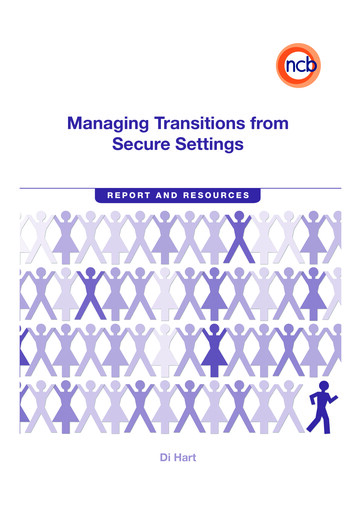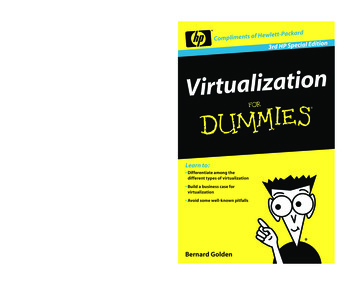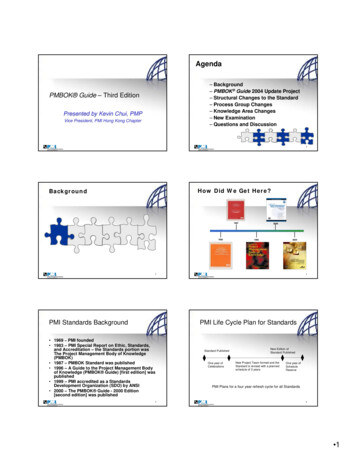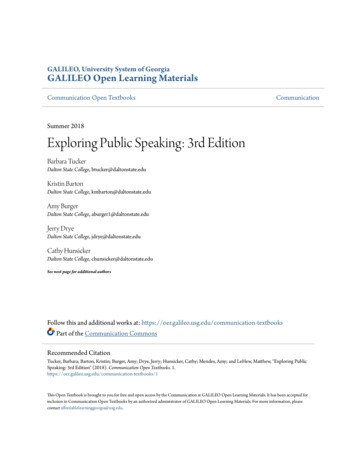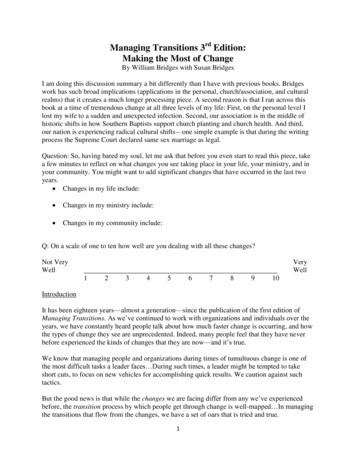
Transcription
Managing Transitions 3rd Edition:Making the Most of ChangeBy William Bridges with Susan BridgesI am doing this discussion summary a bit differently than I have with previous books. Bridgeswork has such broad implications (applications in the personal, church/association, and culturalrealms) that it creates a much longer processing piece. A second reason is that I ran across thisbook at a time of tremendous change at all three levels of my life: First, on the personal level Ilost my wife to a sudden and unexpected infection. Second, our association is in the middle ofhistoric shifts in how Southern Baptists support church planting and church health. And third,our nation is experiencing radical cultural shifts—one simple example is that during the writingprocess the Supreme Court declared same sex marriage as legal.Question: So, having bared my soul, let me ask that before you even start to read this piece, takea few minutes to reflect on what changes you see taking place in your life, your ministry, and inyour community. You might want to add significant changes that have occurred in the last twoyears. Changes in my life include: Changes in my ministry include: Changes in my community include:Q: On a scale of one to ten how well are you dealing with all these changes?Not VeryWellVeryWell12345678910IntroductionIt has been eighteen years—almost a generation—since the publication of the first edition ofManaging Transitions. As we’ve continued to work with organizations and individuals over theyears, we have constantly heard people talk about how much faster change is occurring, and howthe types of change they see are unprecedented. Indeed, many people feel that they have neverbefore experienced the kinds of changes that they are now—and it’s true.We know that managing people and organizations during times of tumultuous change is one ofthe most difficult tasks a leader faces During such times, a leader might be tempted to takeshort cuts, to focus on new vehicles for accomplishing quick results. We caution against suchtactics.But the good news is that while the changes we are facing differ from any we’ve experiencedbefore, the transition process by which people get through change is well-mapped In managingthe transitions that flow from the changes, we have a set of oars that is tried and true.1
First, the results you are seeking depend on getting people to stop doing things the old way andgetting them to start doing things a new way. And since people have a personal connection tohow they work, there is just no way to do that impersonally.And second, transition management is based on some abilities you already have and sometechniques you can easily learn it is a way of dealing with people that makes everyone feelmore comfortable.We have learned how self-defeating it is to try to overcome people’s resistance to changewithout addressing the threat the change poses to their world.Practicing transition management skills taps into innate wisdom that you have sharpened throughthe years, and gives tools and methods for learning new ways. Understanding this will give youthe opportunity to lead with confidence, communicate with clarity, and reassure your people thatthey are following a roadmap. Employees can take comfort in the message that we’ve been herebefore. (pages ix-xi)Processing Activity: What are some of the principles of change and transition that the authorsidentify in their introduction?The ones I saw are: Changes are inevitable. The rate of change is accelerating. The types of changes we are experiencing today are unprecedented. Although even the best leaders cannot anticipate all the changes that are coming, allleaders can improve their effectiveness in helping their organization through thetransition process. Effective leaders understand the relational side of organizational life and duringtransitions they elevate rather than neglect those personal connections. Effective transition management requires a leader to understand and address the personalthreat that the current change is causing their team members. As a leader you cannot always tell your team, “We are on top of every change that comesour way,” but you can tell them “We’ve successfully dealt with change before, and if wemanage this transition properly, we will come out stronger in the end.”The book is broken down into four parts: The Problem, The Solution, Dealing withNonstop Change in the Organization and Your Life, and The Conclusion. It also comeswith five very practical appendices.PART ONE: THE PROBLEMChapter One: It Isn’t the Changes That Do You InA. The chapter begins with a Chinese proverb: “The beginning of wisdom is to call things bytheir right names.” The authors then promptly define the words CHANGE and2
TRANSITION. “Change is situational: the move to a new site, the retirement of the founder,the reorganization of the roles on the team, the revisions to the pension plan. Transition, onthe other hand is psychological: it is a three-phase process that people go through as theyinternalize and come to terms with the details of the new situation that the change bringsabout When change happens without people going through a transition, it is just arearrangement of the chairs.”Understanding the three-phase process is worth the price of the book. And because a pictureis worth a thousand words, here is how they picture that process:TIMEThe three phases are:1. Ending—Letting go of the old ways and the old identity people had. This first phase oftransition is an ending, and the time when you need to help people deal with their losses.2. Neutral Zone—Going through an in-between time when the old is gone but the new isn’tfully operational. It’s when the critical psychological realignments and repatternings takeplace.3. Beginning—Coming out of the transition and making a new beginning. This is whenpeople develop the new identity, experience the new energy, and discover the new senseof purpose that makes the change begin to work.Because transition is a process by which people unplug from an old world and plug into anew world, we can say that transition starts with an ending and finishes with a beginning.(pages 3-5)Processing Questions: Would you agree with the authors that although we often use theminterchangeably, change and transition are very different? Why or why not?3
Q: Take a minute and think about a specific and significant change that is taking place rightnow in your life or in your ministry—one that you did not initiate. Can you see all threephases?Q: Looking at a current change that is taking place in your ministry setting, can you seewhere your team members are in the transition process? How about yourself?Q: Take a few more minutes to reflect on each of these three phases. What personaladjustments have you had to make and what emotions have you felt during this transitionexperience?As I read this section for the first time, I was personally experiencing a significant number ofchanges both personally and professionally. Some that I was initiating as a leader and severalthat I had to lead others to accept while I was transitioning with them. As I was wrapping upthis discussion summary I experienced the sudden and untimely death of my wife—sociologists say it is THE most challenging transition in life. As such, I thought the term“Neutral Zone” was not a strong enough term to describe the emotions that could be presentin a major change situation. At first, I called it the DMZ (de-militarized zone) and then latersettled on the term “Disputed Territory” to reflect the deep emotions and push backs that Iexperienced and observed.Q: As a ministry leader, how will taking time to reflect on your personal experience withchange and the transitions that they bring help you be more effective as you lead yourleadership team and your ministry through transitions?Activity: Ask your team members for honest feedback on how they worked through the threephases as it relates to a recent change you initiated.B. Several important differences between change and transition are overlooked when peoplethink of transition as simply gradual or unfinished change or when they use change andtransition interchangeably. With a change, you naturally focus on the outcome that thechange produces. If you move from California to New York City, the change involvescrossing the country and then learning your way around the Big Apple.Transition is different. The starting point for dealingUnmanaged transitionwith transition is not the outcome but the ending thatmakes changeyou’ll have to make to leave the old situation behind.unmanageable.Situational change hinges on the new thing, butpsychological transition depends on letting go of theold reality and the old identity you have before the change took place. Organizationsoverlook that letting-go process completely, and do nothing about the feelings of loss that itgenerates. And in overlooking those effects, they nearly guarantee that the transition will bemismanaged and that, as a result, the change will go badly. Unmanaged transition makeschange unmanageable.4
Transition starts with an ending. That is paradoxical, but true The failure to identify andget ready for endings and losses is the largest difficulty for people in transition. And thefailure to provide help with endings and losses leads to more problems for organizations intransition than anything else Once you understand that transition begins with letting go ofsomething, you have taken the first step in the task of transition management. (pages 6-8)Q: How would you describe the paradoxical concept that “transition starts with an ending”to someone who has not read the book?Q: As you reflected back on a recent personal experience with transition, what were some ofthe things that you had to “let go” before you could complete the change process? Arethere still some things that you need to let go?C. The second step is understanding what comes after the letting go: the neutral zone. This isthe psychological no-man’s–land between the old reality and the new one.It is important for people to understand and not be surprised by this neutral zone, for severalreasons. First, if you don’t understand and expect it, you’re more likely to try to rush throughor even bypass the neutral zone. You may mistakenly conclude that the confusion you feel isa sign that something is wrong with you.Second, you may be frightened in this no-man’s-land and try to escape. (Employees do thisfrequently, which is why there is often an increased level of turnover during organizationalchanges.)Third, if you escape prematurely from the neutral zone, you’ll not only compromise thechange but also lose a great opportunity. Painful though it is, the neutral zone is theindividual’s and the organization’s best chance to be creative, to develop into what they needto become, and to renew themselves. The neutral zone is thus both a dangerous and anopportune place, and it is the very core of the transition process.Calling them “phases” makes it sound as though they are lined up like rooms in a house,Perhaps it would be more accurate to think of them as three processes and to say that thetransition cannot be completed until all three have taken place. (pages 8-9)Q: As ministry leaders, we work primarily with volunteers. Bridges points out that employeeturnover increases during transitions. So if employees, who are paid, often leave duringtransitions, what will happen to your ministry if you don’t lead change and transitionswell?Q: Does this reality heighten your interest in the principles identified in this book? If not,why not?Q: Think back to t time when “you escaped.” What would have helped you to stay andcomplete the transition?5
Chapter Two: A Test CaseThe chapter opens with the quotation, “We think in generalities, but we live in detail.” The quotebrought to my mind the old cliché, “the devil’s in the details.” The author’s noted that “Chapter 1was fairly theoretical. Unless you understand the basic transition model, you won’t be able to useit. But only in actual situations can you use it.” (page 11)This chapter provides an excellent example from the corporate world of a major change thatdidn’t go well, because leaders didn’t manage the personal impact on employees. It then suggestsa number of actions that “could be taken” to improve the situation and asks the reader to rate theimportance of each possible action on a scale of 1-5 with one being do it NOW and 5 being don’tdo it at all.Q: If you have the book and worked through the exercise, how well did your responses alignwith the author’s?Processing Activity: Select a current change that is impacting your life. Begin a list of all thevarious things you could do to help yourself, your team, and your ministry to manage theresulting transition. As you continue to read the book and/or work through theseprocessing questions, keep adding to your list additional action items as well as notesnext to each action indicating what level of response it should be (1-5) and why.PART TWO: THE SOLUTIONSChapter Three: How to Get People to Let GoA. Bridges opens the chapter with the realities that “Before you can begin something new, youhave to end what used to be, [and] people don’t like endings.” (page 23)To these realities, I would add two personal observations: people have differing levels oftolerance to change and people want their church to be a haven of rest and stability in ourchaotic world. Both of these realities create additional difficulties for churches and ministriesseeking to make necessary changes. Most pastors and ministry leaders are “people pleasers”and do not desire to offend nor do they like to lose members. So when they encounter peoplein significant leadership positions whose tolerance for change is very low, they can becometoo cautious. There are a few people in every church who will be opposed to almost ANYchange a pastor will suggest. These individual’s willingness to change is so limited that evenafter a change has been made, is fantastically successful, and has sustained that success foryears, they will still only begrudgingly admit that the “new idea isn’t as bad as they thought itwas going to be.” Effective leaders are change agents, so they can’t wait for every member tobe ready. But they cannot be like the people who are at the opposite end of the spectrum.There are some people in your church (and I’ve met a few pastors in this category) who willhear a new idea and wonder why it wasn’t implemented last month. And they are willing toaccept it BEFORE they even fully understand what the change is or what its implicationsmight be for the church.6
My second observation is that in general church members want their church to be a safehaven. They want it to be a place where they can escape the chaos of everyday life. Yes,there are a handful of churches in the world that have a core value of being flexible so theywill be able to meet changing needs, but it’s probably not YOUR church.These two observations magnify the author’s statement that “people don’t like endings.”Remember he is writing primarily for a business audience working with employees and notthe ministry world where leaders are working primarily with volunteers.Q: How would you describe your tolerance for change?VeryLowVeryHigh12345678910Action Item: Next time your leadership team meets, discuss the concept of a “personaltolerance for change” and have each individual describe theirs. Also ask, “are therecertain types of changes that you can tolerate better?”B. I believe you can become a more effective change agent, if you will effectively process theinformation in this chapter. Here are the section headings for the chapter: Identify Who’s Losing What Accept the Reality and Importance of the Subjective Losses Don’t Be Surprised at Overreaction Acknowledge the Losses Openly and Sympathetically Expect and Accept the Signs of Grieving Compensate for the Losses Give People Information, and Do It Again and Again Define What’s Over and What Isn’t Mark the Endings Treat the Past with Respect Let People Take a Piece of the Old Way with Them Show How Endings Ensure the Continuity of What Really MattersAction Item: Think about a change you tried to implement as a leader that didn’t go well.Review the list above and identify one or two things that you think might havecontributed most to that failure. As you read and review those particular sections, takespecial note of Bridges suggestions.C. Under the “Identify Who’s Losing What” section he suggests that an effective leader willtake time to answer five critical questions:Q: What is actually going to change? Be specific and describe the change in as much detailas you can.7
Q: What are the secondary changes that your change will probably cause? And what are thefuture changes that those secondary changes will cause?Q: Who is going to have to let go of something and what are those things?Q: How many of the changes are concrete and how many are emotional and subjective?Q: Is there something that is over for everyone? (page 25)D. In his “Accept the Reality and Importance of the Subjective Losses” section he states, “Youwon’t get people’s commitment unless you understand them and make decisions based onthat understanding. So however you do it, learn who is experiencing a loss of some kind andwhat it is they are losing.”In a somewhat related section entitled “Don’t Be Surprised at Overreaction” he encouragesus to remember two things: “first, that changes cause transitions, which cause losses, and it isthe losses, not the changes, that they’re reacting to; and second, that it’s a piece of theirworld that is being lost, not a piece of ours, and we often react that way ourselves when it’spart of our own world that is being lost Overreacting also comes from the experience thatpeople have had with loss in the past Overreactions also take place when a small loss isperceived as the first step in a process that might end with removing the grievers themselves.Someone whose job seemed secure is dismissed, and 100 coworkers begin to wonder, Am Inext?”Q: Think of a time when you over reacted. What were the reasons you responded as you did?And in a third section called “Acknowledge the Losses Openly and Sympathetically,”Bridges states, “You need to bring losses out into the open—acknowledge them and expressyour concern for the affected people. Do it simply and directly it is not talking about a lossbut rather pretending that it doesn’t exist that stirs up trouble research on what helps peoplerecover from loss agrees that they recover more quickly if the losses can be openlydiscussed.” (pages 26-28)Action Item: Take time to reflect on a current change that you are either contemplating orhave recently initiated in your ministry. Review the principles above and ask yourselfhow well you have applied them. What specific actions could you take in the days aheadto help yourself and others to work through the transition process that the change hascreated?E. The next section in the chapter is entitled “Expect and Accept the Signs of Grieving.”Bridges points out that we will find the stages of grief “in families that have lost a loved one,and you find them in an organization where an ending has taken place.” Most ministryleaders are familiar with these: Denial Anxiety Depression Anger Sadness Bargaining Disorientation8
And in a related section, “Compensate for the Losses,” he writes, “No pain no gain, they say.But many change efforts fail because the people affected experience only the pain. As aleader you may know that in the long run the ministry will experience gain, but too often forthe volunteers who are part of your team, it can seem to be all loss—they are only feeling thepain. Trying to talk them out of their feelings will get you nowhere. Find a way to act Ask,What can I give back to balance what’s been taken away? (pages 30-31)Q: Think through a recent major change that you experienced that was not self-initiated. Didyou experience some of the “signs of grief?” Did you feel like you lost more than yougained in the process? What things could the person or people who initiated the changehave done to make your situation better.Q: Think through the Biblical transition between Samuel as the last judge and Saul as thefirst king. What did the people gain and what did they lose in that process?F. “Give People Information, and Do It Again and Again” is the next section. It opens with thestatement, “There are lots of rationalizations for not communicating. Here are some commonones: They don’t need to know yet. We’ll tell them when the time comes. It’ll just upset themnow. They already know. We announced it—threatening information is absorbed remarkablyslowly. Find different ways to say it and different media in which to say it I told the [ministry leaders]. It’s their job to tell [their team]. We don’t know all the details yet ourselves, so there’s no point in saying anything untileverything has been decided.In an effort to protect people sometimes ministry leaders “substitute a fabrication of halftruths and untruths. Not only do these later turn out to be outright lies, but [leaders] often tripthemselves up with inconsistencies and new stories to cover the old inconsistencies.The next section, “Define What’s Over and What Isn’t” has related information. “One of themost important leadership roles during times of change is that of putting into words what it istime to leave behind [Leaders] risk three equally serious and difficult reactions when theydo not specify what is over and what isn’t:1. People don’t dare to stop doing anything; they try to do all the old things and the newthings. Soon they burn out with the overload.2. People make their own decisions about what to discard and what to keep, and the result isinconsistency and chaos.3. People toss out everything that was done in the past, and the baby disappears with thebathwater. (pages 32-33)Q: Think about the last time you initiated a major change. Looking back, what could youhave done to communicate more clearly and more consistently? What will you dodifferently next time?9
Q: As I wrote this discussion summary, I had to work through a situation where a ministryleader told “a half-truth” that came back to bite us. Think about a time when you madethe same mistake in “an effort to protect someone.” How could you have done a betterjob of balancing grace AND truth?G. The next three sections are also somewhat related. “Mark the Endings:” Don’t just talk about the endings—create actions or activities thatdramatize them. “Treat the Past with Respect:” Present innovations as developments that build on the pastand help to realize its potential. Honor the past for what it has accomplished. “Let People Take a Piece of the Old Way with Them:” Endings occur more easily ifpeople can take a bit of the past with them. You are trying to disengage people from it,not stamp it out like an infection And in particular, you don’t want to make people feelblamed for having been part of it. (pages 34-36)Action Item: I have heard of churches that in the process of replacing an historic sanctuarybuilding have sold bricks from the old building as a fund raiser. What it also did is provide amemento of the old building for long term members. Think about a major change that youare attempting to implement. What are some things you could do to: mark the ending, treat the past with greater respect, and let people move forward with a piece of history?H. In the closing sections he reminds us that the past, which people are likely to idealize duringan ending, was the product of change. When people start talking about ‘the good old days,’it’s easy to imagine that they are describing a peaceful time of stability. But that is selectivememory. There were changes then too. Whenever something that is viewed as a break withthe past turns out successfully, people forget the loss they felt when the change happened andbegin to celebrate it as a ‘tradition.’He goes on to state, “Whatever must end, must end. Don’t drag it out. Plan it carefully, andonce it is done, allow time for healing.” But he continues, “people have to let go of thepresent first. Leaders forget that while the first task of change management is to understandthe desired outcome and how to get there, the first task of transition management is toconvince people to leave home. You’ll save yourself a lot of grief if you remember thedistinction. (pages 36-37)Q: How would YOU describe the two major areas involved in the implementation of a newidea (change and transition)?Q: Has the author convinced you of the importance of understanding and managing thepersonal aspect of organizational change? Why or why not?10
I. The chapter concludes with the following checklist: Have I studied the change carefully and identified who is likely to lose what—includingwhat I myself am likely to lose? Do I understand the subjective realities of those losses to the people who experiencethem, even when they seem to me to be overreacting? Have I acknowledged these losses with sympathy? Have I permitted people to grieve and protected them from well-meant attempts to stopthem from expressing their anger or sadness? Have I publicly expressed my own sense of loss, if I feel any? Have I found ways to compensate people for their losses? Am I giving people accurate information and doing it again and again using a variety ofcommunications media? Have I defined clearly what is over and what isn’t? Have I found ways to “mark the ending?” Am I being careful not to denigrate the past but, when possible, finding ways to honor it? Have I made a plan for giving people a piece of the past to take with them? Have I made it clear how the ending we are making is necessary to protect the continuityof the organization or conditions on which the organization depends? Is the ending we are making big enough to get the job done in one step?And the following process questions: What actions can you take to help people deal more successfully with the endings that aretaking place in your organization? What can you do today to get started on this aspect of transition management? (pages 3738)Chapter Four: Leading People Through the Neutral ZoneA. If this phase lasted only a short time, you could just wait for it to pass. But when the changeis deep and far-reaching, this time between the old identity and the new can stretch out formonths, even years. As Andre Gide, French novelist, put it, “One doesn’t discover new landswithout consenting to lose sight of the shore for a very long time.”Neutral zones occur not only in organizations but also in individual lives and in the history ofwhole societies The dangers represented by the neutral zone take several forms:1. People’s anxiety rises and their motivation falls.2. People in the neutral zone miss more work than at other times.3. Old weaknesses, previously patched over or compensated for, reemerge in full flower.4. In the neutral zone, people are overloaded, they frequently get mixed signals, and systemsare in flux and therefore are more than normally unreliable.5. Given the ambiguities of the neutral zone, it is easy for people to become polarized: somewant to rush forward and others want to go back to the old ways.6. Disorganized and tired, people respond slowly and halfheartedly to competitive threats. Ifthey are resentful and looking for ways to pay the organization back, they may evensabotage the organization’s ability to respond to the outside attacks.11
It’s the management of the time in the neutral zone that prevents the organization fromcoming apart as it crosses the gap between the old way and the new. The authors provide thefollowing graphic to help us visualize the reality that major change requires what exists to betorn apart and reconfigured in what he calls the neutral zone:After pointing out that the neutralzone is a very difficult time, theauthors provide someencouragement as they share thatit can also be a creative time. Thetask before a leader becomestwofold: first, to get your peoplethrough the neutral zone in onepiece; and second, to capitalize onall the confusion by encouragingthem to be innovative. (pages 3943)Q: Did you take note of the realpossibility that “new changes”you implement can open very“old wounds” from the past? Have you ever heard someone say, “We tried that one, andit doesn’t work?” As a leader, what can you do to minimize the impact of this reality?Q: Did you also note that the “neutral zone” can provide opportunities for creative thinking?As you think about a major change you initiated with some degree of success, how couldyou have encouraged more creativity in the process?B. In a section entitled “Redefine the Neutral Zone,” Bridges provides an illustration of acompany who announced a plant closing at a specific time in the future. The employees atthe plant quickly began to use the metaphor of a sinking ship. The leadership helped themwork through the neutral zone by redefining it as people taking the last voyage. With the newmetaphor they talked about the ship “reaching port,” everyone could ‘disembark” in aplanned fashion, and affirming those who “stayed on board” to make it to port. (pages 44-45)Q: Take a few minutes and think about a major change you are currently trying to initiate.What kind of a metaphor or word picture could you use to create positive energy?C. Pastors and ministry leaders will be able to relate to the analogy he uses in this section. “Theneutral zone is like the wilderness through which Moses led his people. That took 40 years,you remember—not because they were lost but because the generation that had known Egypthad to die off before the Israelites could enter the Promised Land the outlook, attitudes,values, self-images, and ways of thinking that were functional in the past
Managing Transitions 3rd Edition: Making the Most of Change By William Bridges with Susan Bridges I am doing this discussion summary a bit differently than I have with previous books. Bridges work has such broad implications (applications in the personal, church/association, and cultural realms) that it creates a much longer processing piece.File Size: 832KBPage Count: 33
